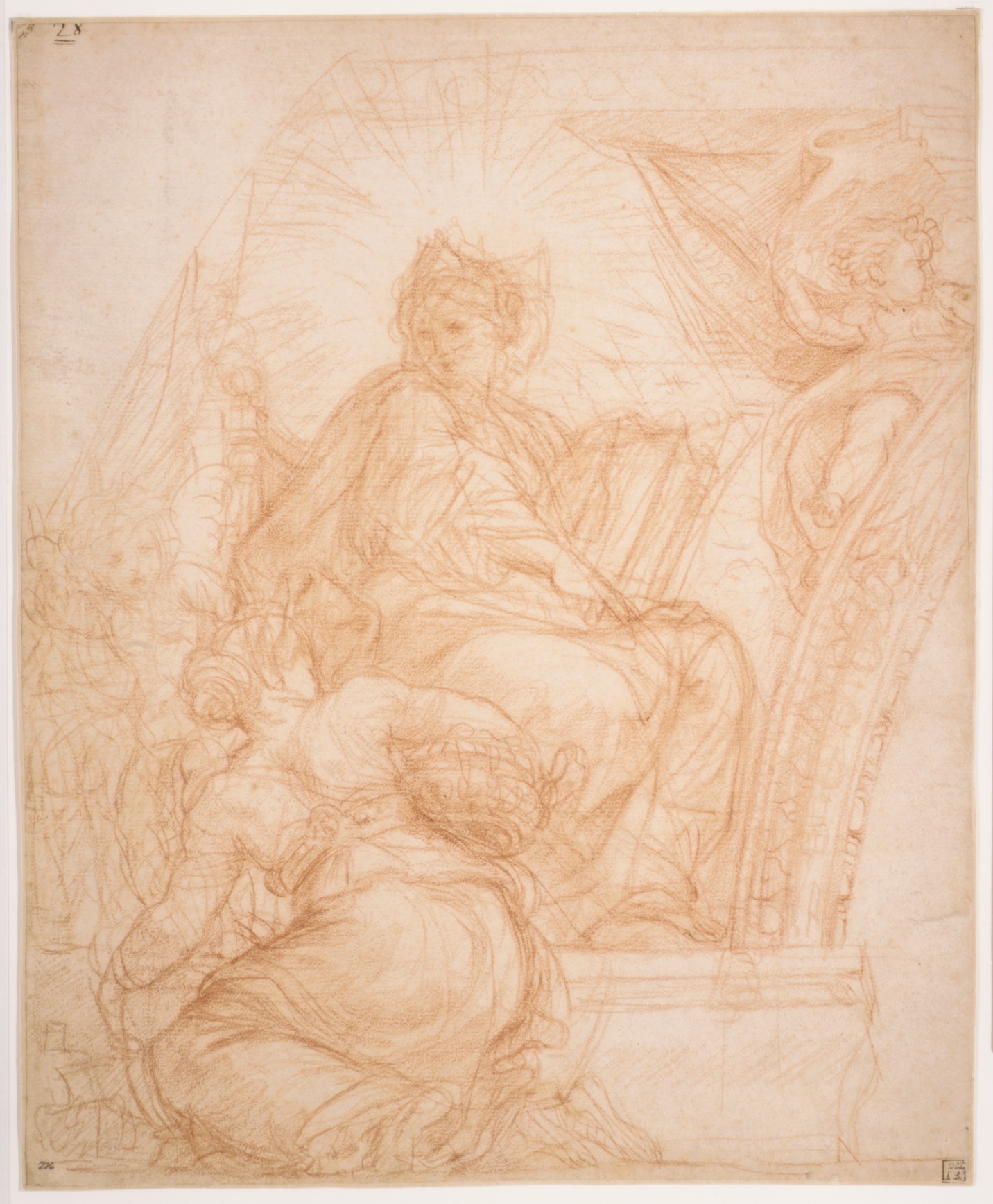Seated Allegorical Figure of Divine Wisdom
Carlo Maratti Italian
Not on view
During the pontificate of Clement X Altieri (1670–1676), his family palace on the Piazza del Gesù in Rome was enlarged and redecorated. Carlo Maratti was commissioned to paint the main room between 1674 and 1677, but only the fresco that fills the long, narrow central section of the vault was executed. The undecorated portions of the vault were to contain allegorical figures representing Religion, Faith, Divine Wisdom, and Evangelical Truth. A document for this never-completed project, this sheet, boldly executed in red chalk, is a preparatory study for the Allegory of Divine Wisdom.
The undecorated portions of the vault are divided by real or fictively painted windows. According to Maratti’s biographer Giovan Pietro Bellori (1613–1696), the four sections of the vaulting at the opposite ends of the Hall were to contain allegorical figures representing Religion, Faith, Divine Wisdom, and Evangelical Truth, respectively. The six spandrels between the windows on the two long sides of the room - three to a side - were to contain representations of Rome with the River Tiber, Peace, Heroic Virtue, Europe, Africa, and Asia with America.
In recent years some twenty-two drawings in collections here and abroad have been identified as preparatory studies by Maratti for the decoration of these spandrels; the most recent and complete listing of the drawings is supplied by Jennifer Montagu. Montagu has also discovered in the Vatican Library a manuscript that gives full descriptions of the iconography of each one of the spandrel subjects. However, this text, which appears to be a scribe's copy of Bellori's original program, speaks of twelve spandrel spaces, giving to Asia and America separate spaces and allotting a fourth spandrel on the other side to a representation of Time. In spite of the miscalculation about the number of spaces available, this manuscript offers iconographic descriptions that are more complete than those in Bellori's life of Maratti.
In the Vatican text the present subject is described in the following way: "La Divina Sapienza starà sedendo stabile septa un cubo; haverà il petto armato, e'l volto scintillante di raggi solari. Terrà nella destra il libro suggellato con li sette suggelli, di cui parla I'Apocalisse, interpretato per gli arcani della sapienza divina. Poserà l'altra mano, e'l braccio sopra un Agnello; poiche il principio della sapienza è il timore di Dio, e l'Innocenza. Sotto di essa apparirà l'Ignoranza fra' l'ornbre, con un lume spento, con gli occhi chiusi, e con gli orecchi asinini" (Montagu 1978, p. 338). On the other hand the subject is described in Bellori's Vita as follows: "divina Sapienza . . . quella tiene lo scettro come governatrice dell'universo ed insieme il libro con i sette signacoli dell'Apocalisse continente i divini misterii, ed appresso di lei un amorino celeste in sembianza cruccioso discaccia l'Ignoranza infida" (Bellori, p. 598). The present composition involves elements mentioned in both descriptions; the lamb mentioned in the Vatican text can just be discerned at the right, and the angry putto described in Bellori's ‘Vita’ appears at the left.
For other preparatory studies by Carlo Maratti for the decoration of the Great Hall of Palazzo Altieri in the Metropolitan Museum of Art see inv. nos. 64.295.1 and 61.169 (Virtue crowned by Honor), 66.53.3 (Allegory of Peace), 2008.334.1 (Study of a Putto), and 65.206 (Plan for a Ceiling and Nude Figures).
Due to rights restrictions, this image cannot be enlarged, viewed at full screen, or downloaded.
This artwork is meant to be viewed from right to left. Scroll left to view more.




